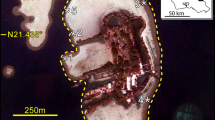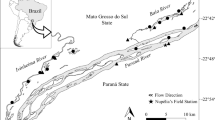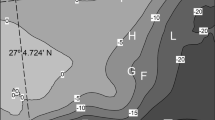Abstract
Two populations of the piscivorous fish Gobiomorus dormitor (the ‘guabina’) were examined in two separate crater lakes in Nicaragua, Central America. At Lake Apoyo, G. dormitor were introduced in May 1991 by local fishermen and have invaded successfully; at Lake Xiloá, the population is naturally occurring. To provide baseline life history data for G. dormitor in both lakes and to test hypotheses related to population growth and invasion success, this study aimed to (1) document and define the population growth and depth distribution of the fish through video transects in Lake Apoyo; (2) compare diet composition between lakes; and (3) compare life history parameters between lakes, including relative growth rates and reproduction. Videotaped transect studies, designed originally to examine cichlid breeding, began in both lakes in 1990 and have documented the subsequent increase of G. dormitor. Yearly means generally fit the exponential growth model. G. dormitor foraged mainly in shallow waters in Lake Apoyo and preyed mostly upon the atherinid Melaniris cf. sardina throughout seasons. In Lake Xiloá, cichlid fry constituted the majority of the diet overall and cannibalism was more common, although this trend varied with the cichlid breeding season. Relative growth rates were significantly different, based on otolith mass regressions on standard length. Lake Apoyo G. dormitor generally behaved as a successful invading species, displaying exponential growth, year-round reproduction, and higher foraging success than the natural population of Lake Xiloá. Further research is planned to explore the G. dormitor invasion when the population becomes integrated into the community.
Similar content being viewed by others
References
Arthington AH (1991) Ecological and genetic impacts of introduced and translocated freshwater fishes in Australia. Canadian Journal of Fisheries and Aquatic Sciences 48(Suppl 1): 33-43
Barlow GW (1976) The Midas cichlid in Nicaragua. In: Thorson TB (ed) Investigations of the Ichthyofauna of Nicaraguan Lakes, pp 333-358. University of Nebraska, Lincoln
Barlow CG,Hogan AE andRodgers LJ (1987) Implication of translocated fishes in the apparent extinction in the wild of the Lake Eacham rainbowfish, Melanotaenia eachamensis. Australian Journal of Marine and Freshwater Resources 38: 897-902
Beverton RJH andHolt SJ (1957) On the dynamics of exploited fish populations. Ministry of Agriculture, Fisheries and Food. Fishery Investigations Series II, Vol XIX. Her Majesty's Stationary Office, London, 533 pp
Bruton MN (1990) The conservation of the fishes of Lake Victoria, Africa: an ecological perspective. Environmental Biology of Fishes 27: 161-175
Courtenay WR, Jr andStauffer JR, Jr (eds) (1984) Distribution, Biology, and Management of Exotic Fishes, Johns Hopkins University Press, Baltimore, Maryland, 430 pp
Demestre M,Moli B,Recasens L andSánchez P (1993) Life history and fishery of Lepidopus caudatus (Pisces: Trichiuridae) in the Catalan Sea (Northwestern Mediterranean). Marine Biology 115: 23-32
Elton CS (1958) The Ecology of Invasion by Plants and Animals, Methuen, London, 181 pp
Francis MP,William MW,Pryce AC,Pollard S andScott SG (1993) Uncoupling of otolith and somatic growth in Pagrus auratus (Sparidae). Fisheries Bulletin 91: 159-164
Gabriel W (1985) Overcoming food limitation by cannibalism: a model study on cyclopoids. Archiv fűr Hydrolbiologie 21: 373-381
Geen GH,Neilson JD andBradford M (1985) Effects of pH on the early development and growth and otolith microstructure of chinook salmon, Oncorhynchus tshawytscha. Canadian Journal of Zoology 63: 22-27
Gross MR andSargent RC (1985) The evolution of male and female parental care in fishes. American Zoology 25: 807-822
Groves RH andBurdon JJ (1986) Ecology of Biological Invasions. Cambridge University Press, Cambridge
Hedgpeth JW (1993) Foreign invaders. Science 261: 34-35
Heins DC andBaker JA (1989) Growth, population structure, and reproduction of the percid fish Percina vigil. Copeia 3: 727-736
Hoenig JM (1983) Empirical use of longevity data to estimate mortality rates. Fisheries Bulletin 82: 898-903
Holčik J (1991) Fish introduction in Europe with particular reference to its Central and Eastern part. Canadian Journal of Fisheries and Aquatic Sciences 48(Suppl 1): 13-23
Kaufman L (1992) Catastrophic change in species-rich freshwater ecosystems: The lessons of Lake Victoria. BioScience 42(11): 846-858
Leonardsson K (1991) Effects of cannibalism and alternative prey on population dynamics of Saduria entomon (Isopoda). Ecology 72(4): 1273-1285
Li HW andMoyle PB (1981) Ecological analysis of species introductions into aquatic systems. Transactions of the American Fisheries Society 110: 772-782
Lodge DM (1993) Biological invasions: lessons for ecology. Trends in Ecology and Evolution 8(4): 133-137
Marshall SL andParker SS (1982) Pattern identification in the microstructure of sockeye salmon (Oncorhynchus nerka) otoliths. Canadian Journal of Fisheries and Aquatic Sciences 39: 542-547
McGurk MD (1984) Ring deposition in the otoliths of larval pacific herring, Clupea harengus pallasi. Fisheries Bulletin 82: 113-120
McKaye KR (1977) Competition for breeding sites between the cichlid fishes of Lake Xiloá, Nicaragua. Ecology 58: 291-302
McKaye KR,Weiland DJ andLim TM (1979a) Comments on the breeding biology of Gobiomorus dormitor (Osteichthyes: Eleotridae) and the advantage of schooling behavior to its fry. Copeia 1979(3): 542-544
McKaye KR,Weiland DJ andLim TM (1979b) The effect of luminance upon the distribution and behavior of the eleotrid fish, Gobiomorus dormitor and its prey. Review Canadian Biology 38: 27-36
McKaye KR,Ryan JD,Stauffer JR, Jr,Lopez Perez LJ, Gabriel I Vega and van den Berghe EP (1995) African tilapia in Nicaragua: ecosystem in transition. BioScience 45(6): 406-411
Miller DJ (1989) Introductions and extinction of fish in the African Great Lakes. Trends in Ecology and Evolution 4(2): 56-59
Miller RR (1966) Geographical distribution of Central American freshwater fishes. Copeia 4: 773-802
Miltner RJ,Ross SW andPosey MH (1995) Influence of food and predation on the depth distribution of juvenile spot (Leiostomus xanthurus) in tidal nurseries. Canadian Journal of Fisheries and Aquatic Sciences 52(5): 971-982
Mosegaard H,Svedäng H andTaberman K (1988) Uncoupling of somatic and otolith growth rates in Arctic char (Salvelinus alpinus) as an effect of differences in temperature response. Canadian Journal of Fisheries and Aquatic Sciences 45: 1514-1524
Moyle PB andLight T (1996) Biological invasions of fresh water: empirical rules and assembly theory. Biological Conservation 78: 149-161
Neilson JS,Geen GH andBottom D (1985) Estuarine growth of juvenile chinook salmon (Oncorhynchus tshawytscha) as inferred from otolith microstructure. Canadian Journal of Fisheries and Aquatic Sciences 42: 899-908
Ogutu-Ohwayo R (1990) The decline of the native fishes of Lakes Victoria and Kyoga (East Africa) and the impact of introduced species, especially the Nile perch, Lates niloticus, and the Nile tilapia, Oreochromis niloticus. Environmental Biology of Fish 27: 81-96
Pawson MG (1990) Using otolith weight to age fish. Journal of Fish Biology 36: 521-531
Penny RW andEvans GT (1985) Growth histories of larval redfish (Sebastes spp.) on an offshore Atlantic fishing bank determined by otolith increment analysis Canadian Journal of Fisheries and Aquatic Sciences 42: 1452-1464
Polis GA (1981) The evolution and dynamics of intraspecific predation. Annual Review of Ecological Systems 12: 225-251
Reidel D (1965) Some remarks on the fecundity of Tilapia (T. mossambica Peters) and its introduction into middle Central America (Nicaragua) together with a first contribution towards the limnology of Nicaragua. Hydrobiologica 25: 357-388
Reznick DN,Lindbeck E andBryga H (1989) Slower growth results in larger otoliths: an experimental test with guppies (Poecilia reticulata). Canadian Journal of Fisheries and Aquatic Sciences 46: 108-112
Rice JA,Crowder LB andBinkowski FP (1985) Evaluating otolith analysis for bloater Coregonus hoyi: do otoliths ring true? Transactions of the American Fisheries Society 114: 532-539
Secor DH andDean JM (1989) Somatic growth effects on the otolith-fish size relationship in young pond-reared striped bass, Morone saxatilis. Canadian Journal of Fisheries and Aquatic Sciences 46: 113-121
Spratt JD (1972) The use of otoliths to separate groups of northern anchovies. California Department of Fish and Game Marine Technical Report 1: 25 pp
Strong DR (1992) Are trophic cascades all wet? Differentiation and donor-control in speciose ecosystems. Ecology 73: 747-754
Templeman W andSquires HJ (1956) Relationship of otolith lengths and weights in the haddock Melanogrammus aeglefinus (L.) to the rate of growth of the fish. Journal of the Fisheries Research Board of Canada 13(4): 467-487
Townsend CR (1996) Invasion biology and ecological impacts of brown trout Salmo trutta in New Zealand. Biological Conservation 78: 13-22
United States Environmental Protection Agency (February 1991) Ecology and management of the zebra mussel and other introduced aquatic nuisance species. EPA/600/3-91/003, Washington, DC
Villa J (1982) Peces nicaraguenses de agua dulce. Coleccion Cultural, Banco de America, Managua, Nicaragua, 253 pp
Waid R (1991) The distribution of the fishes of the crater lakes of Nicaragua. MS thesis, Frostburg State University, Frostburg, Maryland, Department of Biology, Wildlife/Fisheries Biology Program
Wilson CA (1984) Age and growth aspects of the life history of bill-fishes. PhD thesis, University of South Carolina, Columbia, South Carolina
Zaret TM andPaine RT (1973) Species introduction in a tropical lake: a newly introduced piscivore can produce population changes in a wide range of trophic levels. Science 182: 449-455
Author information
Authors and Affiliations
Corresponding author
Rights and permissions
About this article
Cite this article
Bedarf, A.T., McKaye, K.R., Van Den Berghe, E.P. et al. Initial Six-year Expansion of an Introduced Piscivorous Fish in a Tropical Central American Lake. Biological Invasions 3, 391–404 (2001). https://doi.org/10.1023/A:1015806700705
Issue Date:
DOI: https://doi.org/10.1023/A:1015806700705




